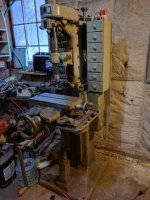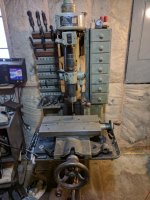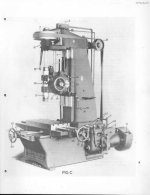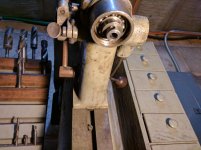Hi all, would anyone be able to give me some information on this machine? I inherited it from my grandfather who was a chief engineer for Indian Motorcycles from 1940-1944. I posted a query about it on a site in the early days of the internet, and someone told me of a specific function that it had that required drilling on an X & Y axis.
My second question is about the quill(?), it requires a drill bit or a drill chuck with a 3/8" shank, but my grandfather had a lot of end mills and collets which I assume he used with this machine though it doesnt look like one could use an end mill that didn't have a 3/8" shank, am I missing something?
And finally, the spindle has a few thousandths of run out which one you are holding a chuck and bit in, equates to much more, any ideas on how I could straighten that situation out?
Here it be:
My second question is about the quill(?), it requires a drill bit or a drill chuck with a 3/8" shank, but my grandfather had a lot of end mills and collets which I assume he used with this machine though it doesnt look like one could use an end mill that didn't have a 3/8" shank, am I missing something?
And finally, the spindle has a few thousandths of run out which one you are holding a chuck and bit in, equates to much more, any ideas on how I could straighten that situation out?
Here it be:










